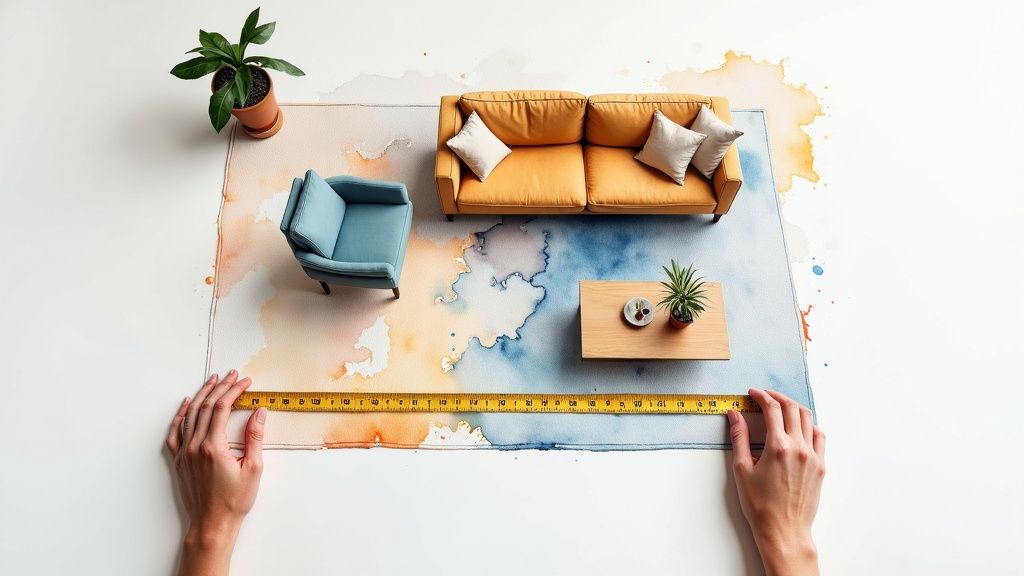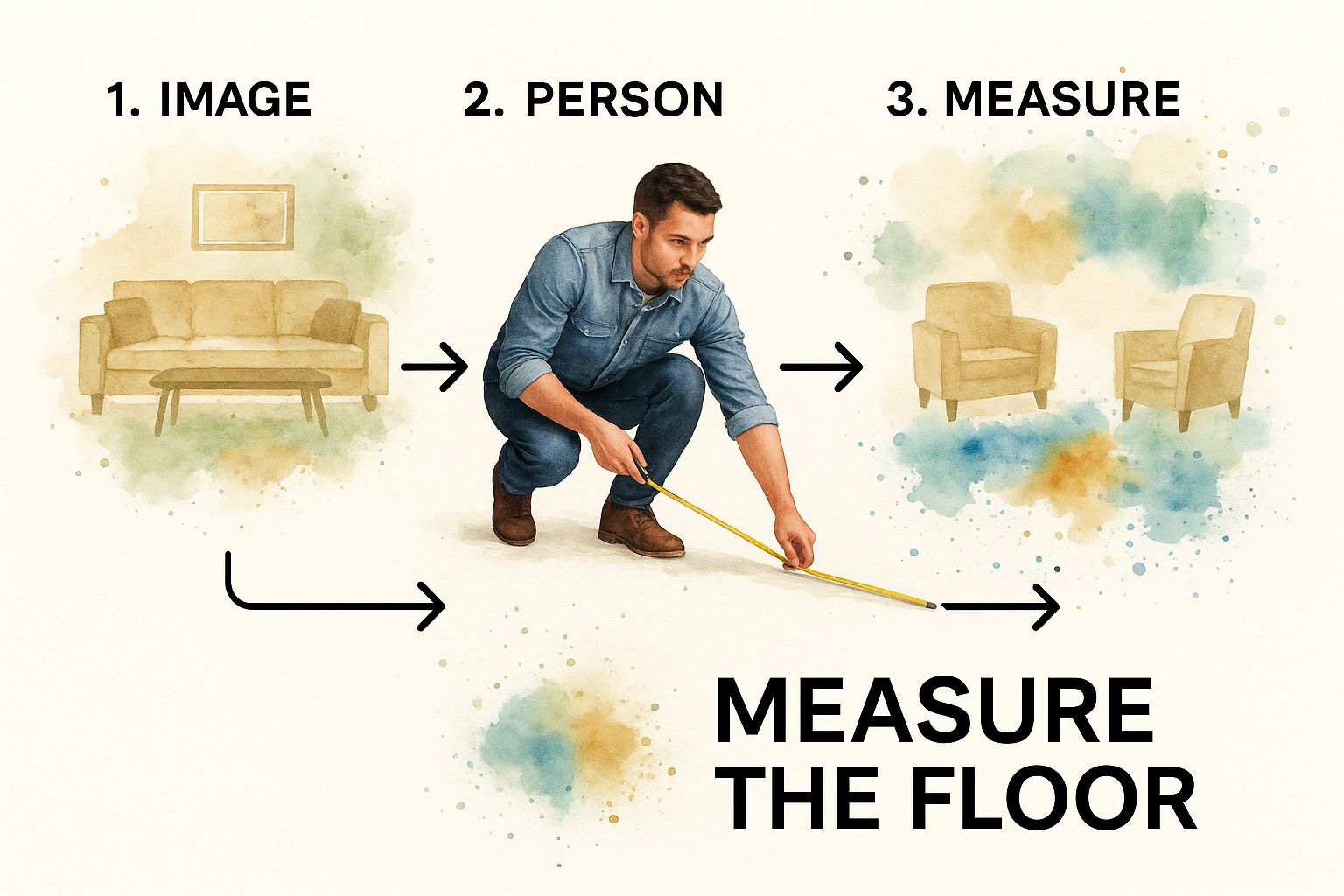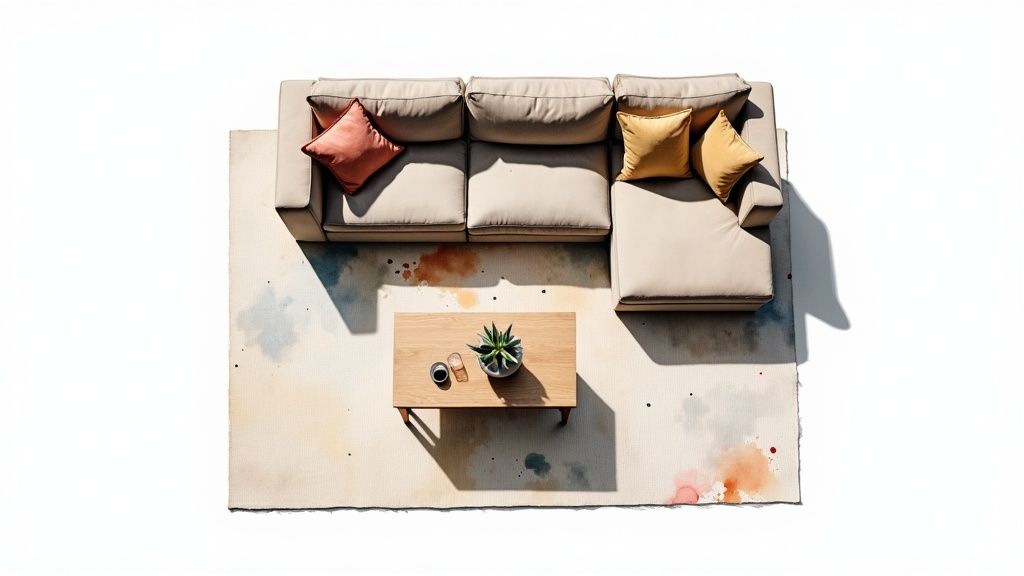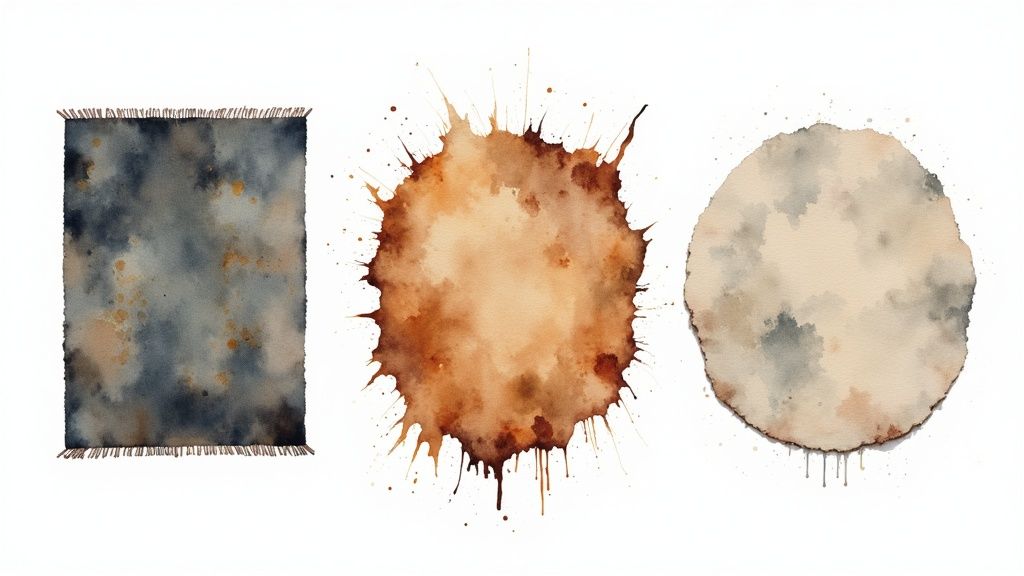How to Choose the Right Rug Size Every Time

Picking the right rug size boils down to a single, crucial idea: your rug needs to anchor the furniture and define the space. It shouldn’t just float in the middle of the floor like a forgotten island. The number one mistake I see people make is choosing a rug that’s too small, which instantly makes a room feel choppy and undersized.
The Foundational Rules of Rug Sizing
Before you even think about color or pattern, get the size right. This is, without a doubt, the most important decision you’ll make. A perfectly scaled rug pulls all your furniture together, creating a sense of harmony that makes the entire room feel thoughtfully designed. It’s the very foundation of your room’s look.
The main goal here is to sidestep the classic “postage stamp” rug. You know the one—it’s comically small for the furniture it’s supposed to ground. This not only shrinks your room visually but also makes your furniture layout look awkward and disconnected. A rug that fits the space connects the dots and carves out a welcoming, defined zone.
Understanding Proportions and Borders
One of the key secrets to a professional-looking room is leaving a consistent border of bare floor around the rug. This creates a beautiful frame, preventing the rug from looking like a piece of wall-to-wall carpet that didn’t quite reach the edges.
As a rule of thumb, aim to leave about 18 to 24 inches of visible floor between the edges of your rug and the walls. This creates a clean, balanced look that lets both your beautiful flooring and your new rug stand out.
This isn’t just a designer’s whim; it’s a widely accepted practice. With the residential sector making up over 60% of carpet sales, getting the spatial layout right is a huge priority for homeowners. This concept is a fundamental part of good space planning, which is all about how professionals map out rooms for maximum function and style.
While we’re focused on size, don’t forget about durability—especially in a busy home. If you have little ones running around, you might want to check out some advice on choosing the perfect carpet for homes with children to make sure your investment can handle the chaos of daily life.
Mapping Your Living Room Rug Layouts
The living room is the heart of the home, and the right rug is what pulls it all together. Here’s a little secret from my years of experience: stop measuring your room wall-to-wall. Instead, focus on the conversation area—the space where your sofa and chairs actually live. The rug’s job is to connect these pieces into a single, unified group.
For most living rooms, standard sizes like an 8x10 or 9x12 foot rug are going to be your sweet spot. A great rule of thumb I always follow is to make sure the rug extends at least 6-8 inches past the ends of your sofa on both sides. This simple trick keeps the rug from looking like a tiny, forgotten postage stamp under your largest piece of furniture.
The Front Legs On Approach
One of the most popular and practically foolproof methods is what I call the “front legs on” layout. You simply place the front two legs of your sofa and any surrounding armchairs right onto the edge of the rug. This technique does a beautiful job of anchoring the seating area without completely covering your floors.
It creates a really cohesive look while letting your hardwood or tile peek through, which helps a room feel more open and airy. An 8x10 rug, for example, is almost always a perfect match for a standard three-seater sofa and a couple of accent chairs arranged this way. It’s a designer’s go-to for a reason!
Going All In: All Legs On the Rug
Have a more spacious living room or a “floating” furniture arrangement where nothing is pushed against a wall? Then you’ll want to go with the “all legs on” approach. This is exactly what it sounds like: your entire sofa, chairs, and coffee table sit completely on the rug, creating a defined and luxurious island.
This layout really makes a statement and works best with larger rugs, like a 9x12 or even a 10x14.
This infographic is a great visual for seeing how the furniture dictates the rug size, not the other way around.

The main thing to remember is that your furniture placement should be your guide, not the room’s dimensions.
Pro Tip: If you’re ever stuck between two sizes, always go for the bigger one. A rug that’s slightly too big makes a room feel intentional and pulled together. One that’s too small just makes everything feel disjointed and can cheapen the entire look.
Of course, a great rug needs a great layout to shine. For more ideas on positioning everything perfectly, check out our guide on how to arrange living room furniture—it’s the perfect next step.
Perfecting Rug Placement in the Dining Room
The dining room is a special case when it comes to choosing a rug. It’s one of the few places where function truly dictates form. A rug that’s too small is more than just a design faux pas—it’s a genuine annoyance every time someone tries to scoot their chair in.
There’s one golden rule here, and it’s non-negotiable: your rug has to be big enough to fit the table and all the chairs, even when they’re pulled away from the table. Trust me, nothing ruins the flow of a dinner party faster than a chair leg getting snagged on the edge of the rug. It’s awkward and a tripping hazard.
Measuring for Success
So, how do you nail the dimensions? Don’t just eyeball it. The best way is to physically set the scene.
Pull your chairs out from the table, giving them enough room for someone to comfortably sit down. Then, grab a tape measure and get the length and width of that entire setup, from the back legs of the chairs on one side to the back legs on the other. That number you just got? That’s the minimum size your rug can be.

As a rule of thumb, I always aim for a rug that extends at least 24 inches beyond the edge of the table on all sides. This buffer is your best friend—it guarantees chairs can slide back smoothly without ever catching.
This isn’t just some arbitrary designer tip; it’s a practical standard that prevents a lot of headaches. It also happens to be a guideline you’ll see reflected in consumer trends, which you can learn more about through detailed market research.
Matching Shape to Your Table
Another thing to consider is shape. The most cohesive, put-together dining rooms are ones where the rug’s shape echoes the table’s shape. It just feels right.
- Rectangular Tables: An easy one. Go with a rectangular rug.
- Round Tables: A round rug is a natural fit, but a large square one can also look fantastic.
- Square Tables: Stick with a square rug to maintain that clean, geometric look.
Following this simple principle ensures your rug frames your dining set perfectly, creating a space that feels intentional and beautifully designed.
Creating a Cozy Foundation in the Bedroom
The right rug can completely transform your bedroom, turning it from just a place to sleep into a genuine sanctuary. The idea is to create a soft, warm foundation that feels amazing the moment your feet hit the floor in the morning. How you get there really depends on your bed size and the overall vibe you’re aiming for.
One of my favorite approaches, especially for a grand, cohesive look, is to place a large 9x12 foot rug completely under a King bed and its nightstands. This “full coverage” method essentially frames the entire sleeping area, which makes the room feel more expansive and thoughtfully designed. It creates a single, unified zone that anchors all your bedroom furniture.

Finding the Perfect Partial Placement
But here’s the thing: you don’t have to cover the entire floor to make a huge impact. A more popular and often more budget-friendly option is what I call the “two-thirds” placement.
This just means sliding a rug—say, an 8x10 for a Queen bed—under the bottom two-thirds of the bed, stopping just short of your nightstands. This layout still gives you that all-important 18-24 inches of soft landing space on either side, which is key.
This strategy is both effective and practical. In fact, market trends show that a 5x8 feet rug is a top choice for smaller spaces like bedrooms or home offices, hitting that sweet spot between cost and comfort. As noted in this global carpets and rugs market report, the rise of online shopping has given people better access to size guides and visualization tools, making it much easier to pick the right rug from the get-go.
Getting the Rug Size Right in Hallways and Entryways
Let’s not forget the spaces that connect our homes. Hallways and entryways are more than just thoroughfares; they’re the first and last impression. A well-chosen rug here not only adds a pop of personality but also protects your floors from the daily grind of foot traffic.
For those long, skinny hallways, a runner is almost always the answer. The real trick is getting the proportions just right. I’ve seen it countless times: a runner that’s too narrow or stops short, making the whole space feel awkward and off-balance.
Perfect Proportions for Your Hallway
What you’re aiming for is a balanced, intentional look—a clear visual path that guides the eye. The secret is to leave a little bit of your original flooring showing all the way around the rug.
- For width, you’ll want to see about 4 to 6 inches of bare floor on either side of the runner.
- For length, make sure the runner doesn’t butt up against the wall or spill into the next room. Leaving around 6 inches of floor exposed at each end is the sweet spot.
This little bit of negative space acts like a frame, making the hallway feel wider and more thoughtfully put together.
A Pro Tip From Experience: If you have a very long, hotel-style hallway, don’t be afraid to use two runners instead of one massive one. Just leave a small, uniform gap of flooring between them to keep it looking clean and deliberate.
Sizing for Foyers and Kitchens
Your entryway rug sets the tone for your entire home. The main goal here is to find a size that feels substantial without getting in the way. Always measure how much room your front door needs to swing open freely. A rug that bunches up against the door every time you open it is a trip hazard waiting to happen.
Runners also work wonders in the kitchen, especially in galley layouts or placed in that high-traffic zone in front of the sink and stove. And for a breakfast nook? Treat it like a mini dining room. A small round or square rug that’s big enough for the chairs to slide in and out is perfect.
Common Rug Sizing Dilemmas Solved
Even with all the rules and measurements, you might still run into a few tricky situations. What do you do if your room has a weird layout? Or if you find a rug you absolutely love, but it’s just a little off in size? Let’s walk through some of these common last-minute hurdles.
Is It Okay to Layer Rugs?
Yes, and you absolutely should! Layering is one of my favorite designer tricks, especially when you can’t find that one perfect rug. It’s a brilliant way to solve sizing issues and add a ton of personality to a room.
The key is to start with a large, neutral base rug—think jute or sisal—that correctly fits the space and anchors your main furniture. Then, you can layer a smaller, more decorative rug on top to define the central conversation area and bring in color or pattern.
How Do I Handle an Awkwardly Shaped Room?
If you’re dealing with an L-shaped living room or another unusual layout, resist the temptation to find a custom rug that fills the entire floor. It’s often better to use a standard rectangular rug to carve out a specific, functional zone within the larger space.
Focus on grounding your main furniture grouping, like the sofa and chairs, on the rug. This creates a clear, cohesive area and makes the odd shape of the room feel purposeful rather than problematic. Mapping it out first can be a game-changer; you can get a better handle on this by learning how to create floor plans for your space.
My golden rule: when in doubt, go bigger. A rug that’s too small will make your furniture look like it’s adrift in the room. A slightly larger rug, on the other hand, pulls everything together and gives your space a grounded, high-end feel.
Ready to stop guessing? With RoomGenius, you can see exactly how different rug sizes and styles will look in your own home. Try it now!